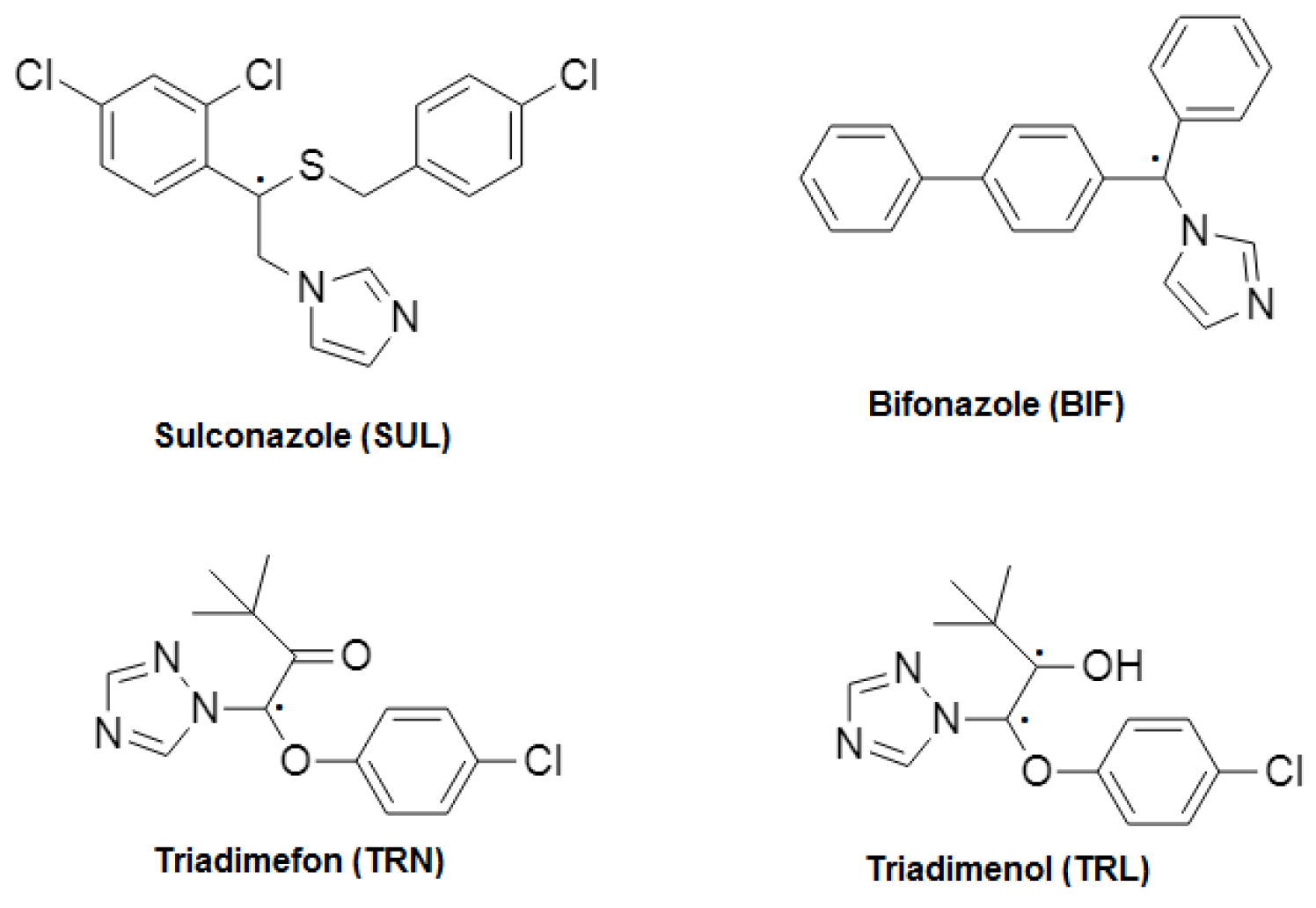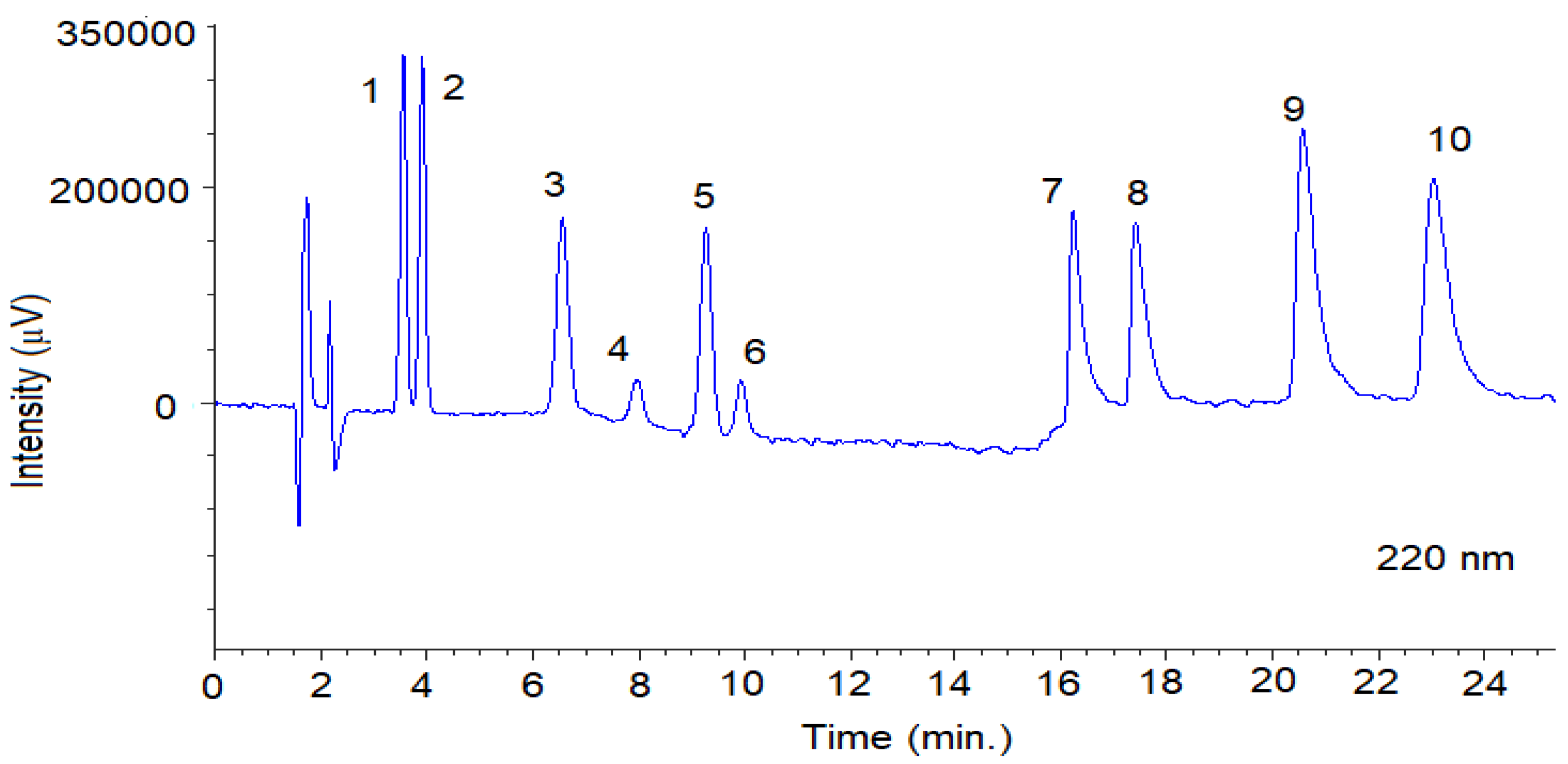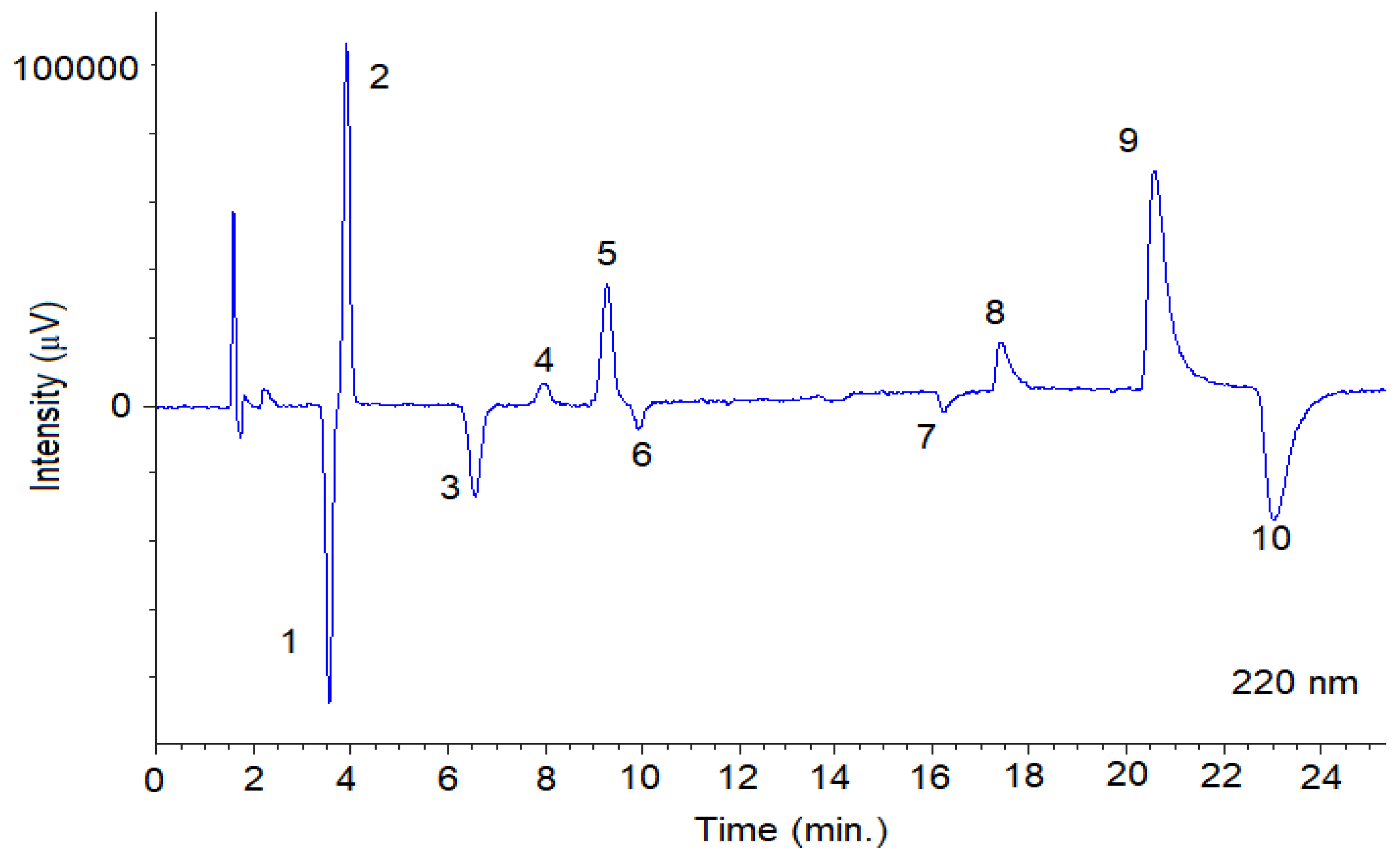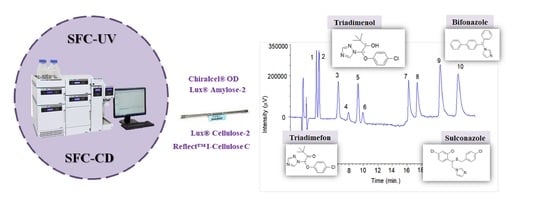Study of Different Chiral Columns for the Enantiomeric Separation of Azoles Using Supercritical Fluid Chromatography
Abstract
:1. Introduction
2. Materials and Methods
2.1. Chemical and Materials
2.2. Chiral Columns
2.3. Supercritical Fluid Chromatography
2.3.1. Instrumentation
2.3.2. Chromatographic Conditions
3. Results and Discussion
3.1. Selection of the Stationary Phase and Composition of the Mobile Phase
3.2. Determination of the Elution Order
3.3. Effect of Temperature
4. Conclusions
Supplementary Materials
Author Contributions
Funding
Data Availability Statement
Conflicts of Interest
References
- Jørgensen, L.N.; Heick, T.M. Azole use in agriculture, horticulture, and wood preservation—Is it indispensable? Front. Cell. Infect. Microbiol. 2021, 11, 730297. [Google Scholar] [CrossRef] [PubMed]
- Safiei, M.; Peyton, L.; Hashemzadeh, M.; Foroumadi, A. History of the development of antifungal azoles: A review on structures, SAR, and mechanism of action. Bioorg. Chem. 2020, 104, 104240. [Google Scholar] [CrossRef] [PubMed]
- Draskau, M.K.; Svingen, T. Azole fungicide and their endocrine disrupting properties: Perspectives on sex hormone-dependent reproductive development. Front. Toxicol. 2022, 4, 883254. [Google Scholar] [CrossRef] [PubMed]
- Bicchi, C.; Cravotto, G.; D’amato, A.; Rubiolo, P.; Galli, A.; Galli, M. Cyclodextrin derivatives in gas chromatography separation of racemates with different volatility. Part XV: 6-o-t-Butyldimethylsilyl-versus 6-o-t-Heayldimethylsilyl- β and -γ Derivates. J. Microcolumn Sep. 1999, 11, 487–500. [Google Scholar] [CrossRef]
- Wu, Y.S.; Lee, H.K.; Li, S.F. Simultaneous chiral separation of triadimefon and triadimenol by sulfated beta-cyclodextrin-mediated capillary electrophoresis. Electrophoresis 2000, 21, 1611–1619. [Google Scholar] [CrossRef]
- Li, W.; Zhao, L.; Zhang, H.; Chen, X.; Chen, S.; Zhu, Z.; Hong, Z.; Chai, Y. Enantioseparation of new triadimenol antifungal active compounds by electrokinetic chromatography and molecular modeling study of chiral recognition mechanisms. Electrophoresis 2014, 35, 2855–2862. [Google Scholar] [CrossRef]
- Wei-Li, W.; Bao-Yuan, G.; Jin-Ming, L. Ultra-high concentration of amylose for chiral separations in capillary electrophoresis. J. Chromatogr. A 2009, 1216, 1484–1489. [Google Scholar] [CrossRef]
- Salido-Fortuna, S.; Marina, M.L.; Castro-Puyana, M. Enantiomeric determination of econazole and sulconazole by electrokinetic chromatography using hydroxypropyl-β-cyclodextrin combined with ionic liquids based on L-lysine and L-glutamic acid. J. Chromatogr. A 2020, 1621, 461085. [Google Scholar] [CrossRef]
- Chen, J.; Du, Y.; Zhu, F.; Chen, B.; Zhang, Q.; Du, S.; Li, P. Study of the enantioseparation capability of chiral dual system based on chondroitin sulfate C in CE. Electrophoresis 2015, 36, 607–614. [Google Scholar] [CrossRef]
- Castro-Puyana, M.; Crego, A.L.; Marina, M.L.; García-Ruiz, C. Enantioselective separation of azole compounds by EKC. Reversal of migration order of enantiomers with CD concentration. Electrophoresis 2007, 28, 2667–2674. [Google Scholar] [CrossRef]
- Salido-Fortuna, S.; Greño, M.; Castro-Puyana, M.; Marina, M.L. Amino acid chiral ionic liquids combined with hydroxypropyl-β-cyclodextrin for drug enantioseparation by capillary electrophoresis. J. Chromatogr. A 2019, 1607, 460375. [Google Scholar] [CrossRef] [PubMed]
- Aboul-Enein, H.Y.; Ali, I. Comparative study of the enantiomeric resolution of chiral antifungal drugs econazole, miconazole and sulconazole by HPLC on various cellulose chiral columns in normal phase mode. J. Pharm. Biom. Anal. 2002, 27, 441–446. [Google Scholar] [CrossRef] [PubMed]
- Aboul-Enein, H.Y.; Ali, I. Comparison of the chiral resolution of econazole, miconazole, and sulconazole by HPLC using normal-phase amylose CSPs. Anal. Bioanal. Chem. 2001, 370, 951–955. [Google Scholar] [CrossRef] [PubMed]
- Nelander, H.; Andersson, S.; Öhlén, K. Evaluation of the chiral recognition properties as well as the column performance of four chiral stationary phases based on cellulose (3,5-dimethylphenylcarbamate) by parallel HPLC and SFC. J. Chromatogr. A 2011, 1218, 9397–9405. [Google Scholar] [CrossRef]
- Zhang, H.; Qian, M.; Wang, X.; Wang, X.; Xu, H.; Wang, Q.; Wang, M. HPLC-MS/MS enantioseparation of triazole fungicides using polysaccharide-based stationary phases. J. Sep. Sci. 2012, 35, 773–777. [Google Scholar] [CrossRef]
- Ma, S.; Wang, L.; Guo, G.; Tang, J.; Yu, J. The enantioseparation and determination of sulconazole enantiomers in rat plasma and tissues by a chiral HPLC-ESI-MS/MS method and its application to studies on stereoselective pharmacokinetics and tissue distribution. New J. Chem. 2022, 46, 4262–4271. [Google Scholar] [CrossRef]
- Ali, I.; Aboul-Enein, H.Y.; Gaitonde, V.D.; Singh, P.; Rawat, M.S.M.; Sharma, B. Chiral separations of imidazole antifungal drugs on AmyCoat RP column in HPLC. Chromatographia 2009, 70, 223–227. [Google Scholar] [CrossRef]
- Aboul-Enein, H.Y.; Ali, I. Enantiomeric resolution of some imidazole antifungal agents on chiralpak WH chiral stationary phase using HPLC. Chromatographia 2001, 54, 200–202. [Google Scholar] [CrossRef]
- Liu, Y.; Cai, L.; Lun, J.; Zhao, M.; Guo, X. Enantiomeric separation and molecular docking study of seven imidazole antifungal drugs on a cellulose tris-(3,5-dimethylphenylcarbamate) chiral stationary phase. New J. Chem. 2020, 44, 18337–18346. [Google Scholar] [CrossRef]
- Zhang, J.; Sun, J.; Liu, Y.; Yu, J.; Guo, X. Immobilized Cellulose-Based Chiralpak IC Chiral Stationary Phase for Enantioseparation of Eight Imidazole Antifungal Drugs in Normal-Phase, Polar Organic Phase and Reversed-Phase Conditions Using High-Performance Liquid Chromatography. Chromatographia 2019, 82, 649–660. [Google Scholar] [CrossRef]
- Bielejewska, A.; Duszczyk, K.; Zukowski, J. Effect of (+) or (−) camphorsulfonic acid additives to the mobile phase on enantioseparations of some basic drugs on a Chiralcel OD column. J. Chromatogr. A 2005, 1083, 133–140. [Google Scholar] [CrossRef] [PubMed]
- Mskhiladze, A.; Karchkhadze, M.; Dadianidze, A.; Fanali, S.; Farkas, T.; Chankvetadze, B. Enantioseparation of chiral antimycotic drugs by HPLC with polysaccharide-based chiral columns and polar organic mobile phases with emphasis on enantiomer elution order. Chromatographia 2013, 76, 1449–1458. [Google Scholar] [CrossRef]
- Podolska, M.; Bialecka, W.; Kulik, A.; Kwiatkowska-Puchniarz, B.; Mazurek, A. HPLC method for separating enantiomers of imidazole derivatives-antifungal compounds. Acta Pol. Pharm. 2017, 74, 777–784. [Google Scholar] [PubMed]
- Bi, C.; Zhao, E.; Liu, Y.; Qiu, J.; Zhou, Z. Direct optical resolution of chiral pesticides by HPLC on emamectin CSP under normal phase conditions. J. Chromatogr. Rel. 2006, 29, 1601–1607. [Google Scholar] [CrossRef]
- Wang, P.; Jiang, S.; Liu, D.; Wang, P.; Zhou, Z. Direct enantiomeric resolutions of chiral triazole pesticides by high-performance liquid chromatography. J. Biochem. Biophys. Methods 2005, 62, 219–230. [Google Scholar] [CrossRef] [PubMed]
- Liang, H.; Qiu, J.; Li, L.; Li, W.; Zhou, Z.; Liu, F.; Qiu, L. Stereoselective separation and determination of triadimefon and triadimenol in wheat, straw, and soil by liquid chromatography-tandem mass spectrometry. J. Sep. Sci. 2012, 35, 166–173. [Google Scholar] [CrossRef]
- Li, L.; Wang, H.; Shuang, Y.; Li, L. The preparation of a new 3,5-dichlorophenylcarbamated cellulose-bonded stationary phase and its application for the enantioseparation and determination of chiral fungicides by LC-MS/MS. Talanta 2019, 202, 494–506. [Google Scholar] [CrossRef]
- Qiu, J.; Dai, S.; Zheng, C.; Yang, S.; Chai, T.; Bie, M. Enantiomeric separation of triazole fungicides with 3-μm and 5-μml particle chiral columns by reverse-phase high-performance liquid chromatography. Chirality 2011, 23, 479–486. [Google Scholar] [CrossRef]
- Zhou, Y.; Li, L.; Lin, K.; Zhu, X.; Liu, W. Enantiomer separation of triazole fungicides by high-performance liquid chromatography. Chirality 2019, 21, 421–427. [Google Scholar]
- Li, Y.; Dong, F.; Liu, X.; Xu, J.; Li, J.; Kong, Z.; Chen, X.; Liang, X.; Zheng, Y. Simultaneous enantioselective determination of triazole fungicides in soil and water by chiral liquid chromatography/tandem mass spectrometry. J. Chromatogr. A 2012, 1224, 51–60. [Google Scholar] [CrossRef]
- Luo, M.; Liu, D.; Zhou, Z.; Wang, P. A new chiral residue analysis method for triazole fungicides in water using dispersive liquid-liquid microextraction (DLLME). Chirality 2013, 25, 567–574. [Google Scholar] [CrossRef] [PubMed]
- Toribio, L.; del Nozal, M.J.; Bernal, J.L.; Alonso, C.; Jiménez, J.J. Enantiomeric separation of several antimycotic azole drugs using supercritical fluid chromatography. J. Chromatogr A 2007, 4, 255–261. [Google Scholar] [CrossRef] [PubMed]
- Wu, H.; Yu, S.; Zeng, L. Effects of Hexane in Supercritical Fluid Chromatography for the Separation of Enantiomers. Chirality 2016, 28, 192–198. [Google Scholar] [CrossRef] [PubMed]
- Del Nozal, M.J.; Toribio, L.; Bernal, J.L.; Castaño, N. Separation of triadimefon and triadimenol enantiomers and diastereoisomers by supercritical fluid chromatography. J. Chromatogr. A 2003, 986, 135–141. [Google Scholar] [CrossRef]
- Toribio, L.; Bernal, J.L.; Martín, M.T.; Bernal, J.; del Nozal, M.J. Effects of organic modifier and temperature on the enantiomeric separation of several azole drugs using supercritical fluid chromatography and the Chiralpak AD column. Biomed. Chromatogr. 2013, 28, 152–158. [Google Scholar] [CrossRef]
- Toribio, L.; del Nozal, M.J.; Bernal, J.L.; Alonso, C.; Jiménez, J.J. Enantiomeric resolution of bifonazole by supercritical fluid chromatography. J. Sep. Sci. 2006, 29, 1373–1378. [Google Scholar] [CrossRef]
- Mai, B.; Fan, J.; Jiang, Y.; He, R.; Lai, Y.; Zhang, W. Fast enantioselective determination of triadimefon in different matrices by supercritical fluid chromatography. J. Chromatogr. B: Anal. Technol. Biomed. Life Sci. 2019, 4, 1126–1127. [Google Scholar]
- Yao, Z.; Li, X.; Miao, Y.; Lin, M.; Xu, M.; Wang, Q.; Zhang, H. Simultaneous enantioselective determination of triadimefon and its metabolite triadimenol in edible vegetable oil by gel permeation chromatography and ultraperformance convergence chromatography/tandem mass spectrometry. Anal. Bioanal. Chem. 2015, 407, 8849–8859. [Google Scholar] [CrossRef]
- Yang, F.; Zhang, X.; Shao, J.; Xiong, W.; Ji, Y.; Liu, S.; Tang, G.; Deng, H.; Wang, Y. A rapid method for the simultaneous stereoselective determination of the triazole fungicides in tobacco by supercritical fluid chromatography-tandem mass spectrometry combined with pass-through cleanup. J. Chromatogr. A 2021, 1642, 462040. [Google Scholar] [CrossRef]
- West, C. Recent trends in chiral supercritical fluid chromatography. TrAC-Trends Anal. Chem. 2019, 120, 115648. [Google Scholar]
- Kalikova, K.; Slechtova, T.; Vozka, J.; Tesarova, E. Supercritical fluid chromatography as a tool for enantioselective separation: A review. Anal. Chim. Acta 2014, 821, 1–33. [Google Scholar] [CrossRef] [PubMed]
- Deng, H.; Ji, Y.; Tang, S.; Yang, F.; Tang, G.; Shi, H.; Lee, H.K. Application of Chiral and Achiral Supercritical Fluid Chromatography in Pesticide Analysis: A Review. J. Chromatogr. A 2020, 1634, 461684. [Google Scholar] [CrossRef] [PubMed]
- Ali, I.; Raja, R.; Alam, S.D.; Shirsath, V.; Jain, A.K.; Locatelli, M.; David, V. A comparison of chiral separations by supercritical fluid chromatography and high-performance liquid chromatography. J. Liq. Chromatogr. Relat. 2021, 44, 550–563. [Google Scholar] [CrossRef]
- Toribio, L.; Alonso, C.; del Nozal, M.J.; Bernal, J.L.; Jiménez, J.J. Enantiomeric separation of chiral sulfoxides by supercritical fluid chromatography. J. Sep. Sci. 2006, 29, 1363–1372. [Google Scholar] [CrossRef]
- Ares, A.M.; Bernal, J.; Janvier, A.; Toribio, L.J. Chiral and achiral separation of ten flavanones using supercritical fluid chromatography. Application to bee pollen analysis. J. Chromatogr. A 2022, 1685, 463633. [Google Scholar]
- Phinney, K.W.; Stringham, R.W. Chiral Separations Using Supercritical Fluid Chromatography. In Chiral Separation Techniques: A Practical Approach, 3rd ed.; John Wiley & Sons, Inc.: Hoboken, NJ, USA, 2007; pp. 135–154. [Google Scholar]
- Dai, J.; Zhang, Y.; Wang-Iverson, D.B.; Tymiak, A. Supercritical Fluid Chromatography. In ADME-Enabling Technologies in Drug Design and Development; Zhang, D., Surapaneni, S., Eds.; John Wiley & Sons, Inc.: Hoboken, NJ, USA, 2012; pp. 363–380. [Google Scholar]






| Column | Stationary Phase | Dimensions |
|---|---|---|
| Chiralcel® OD | Cellulose- tris(3,5-dimethylphenylcarbamate) coated on silica gel | 250 × 4.6 mm; 10 µm |
| Lux® Cellulose-2 | Cellulose- tris(3-chloro-4-methylphenylcarbamate) coated on silica gel | 250 × 4.6 mm; 5 µm |
| Reflect™ I-cellulose C | Cellulose- tris(3,5-dichlorophenylcarbamate) immobilized on silica gel | 150 × 4.6 mm; 3 µm |
| Lux® Amylose-2 | Amylose-tris(5-chloro-2-methylfenilcarbamate) coated on silica gel | 250 × 4.6 mm; 5 µm |
| Lux® Cellulose-2 | Reflect™ I-Cellulose C | Lux® Amylose-2 | |||||||
|---|---|---|---|---|---|---|---|---|---|
| Sulconazole | |||||||||
| % Modifier | t1/min | t2/min | t1/min | t2/min | t1/min | t2/min | |||
| 30% Methanol | 15.2 | 15.2 | 0.0 (1.0) | 4.3 | 4.3 | 0.0 (1.0) | 4.8 | 4.8 | 0.0 (1.0) |
| 30% Ethanol | 14.2 | 15.6 | 1.7 (1.1) | 5.1 | 5.3 | 0.6 (1.1) | 5.3 | 5.6 | 1.3 (1.1) |
| 30% Isopropanol | 20.9 | 27.6 | 4.7 (1.3) | 12.7 | 12.7 | 0.0 (1.0) | 6.41 | 6.8 | 1.2 (1.1) |
| Bifonazole | |||||||||
| % Modifier | t1/min | t2/min | t1/min | t2/min | t1/min | t2/min | |||
| 30% Methanol | 7.1 | 9.3 | 5.3 (1.4) | 4.0 | 4.3 | 1.1 (1.1) | 7.9 | 13.3 | 7.8 (2.0) |
| 30% Ethanol | 6.7 | 8.9 | 4.2 (1.4) | 4.1 | 4.4 | 1.1 (1.1) | 8.1 | 10.4 | 4.4 (1.4) |
| 30% Isopropanol | 8.8 | 11.9 | 4.4 (1.4) | 8.4 | 9.2 | 0.8 (1.1) | 10.8 | 11.6 | 1.1 (1.1) |
| Lux® Cellulose-2 | Reflect™ I-Cellulose C | Lux® Amylose-2 | |||||||||||||||||||
|---|---|---|---|---|---|---|---|---|---|---|---|---|---|---|---|---|---|---|---|---|---|
| Triadimefon | |||||||||||||||||||||
| % Modifier | t1/min | t2/min | t1/min | t2/min | t1/min | t2/min | |||||||||||||||
| 5% Methanol | 5.3 | 6.1 | 2.9 (1.2) | 2.8 | 3.0 | 0.8 (1.1) | 5.7 | 6.1 | 1.1 (1.1) | ||||||||||||
| 5% Ethanol | 5.5 | 6.6 | 2.9 (1.3) | 4.2 | 4.9 | 1.6 (1.2) | 6.4 | 6.4 | 0.0 (1.0) | ||||||||||||
| 5% Isopropanol | 4.3 | 4.8 | 2.8 (1.2) | 4.6 | 5.8 | 2.2 (1.3) | 6.7 | 7.5 | 2.3 (1.2) | ||||||||||||
| Triadimenol | |||||||||||||||||||||
| % Modifier | t1/min | t2/min | t3/min | t4/min | Rs1–2 | Rs2–3 | Rs3–4 | t1/min | t2/min | t3/min | t4/min | Rs1–2 | Rs2–3 | Rs3–4 | t1/min | t2/min | t3/min | t4/min | Rs1–2 | Rs2–3 | Rs3–4 |
| 5% Methanol | 12.6 | 15.3 | 16.8 | 21.4 | 3.2 (1.2) | 1.7 (1.1) | 4.6 (1.3) | 4.3 | 4.9 | 4.9 | 4.9 | 1.4 (1.2) | 0.0 (1.0) | 0.0 (1.0) | 5.3 | 5.8 | 6.7 | 8.0 | 1.1 (1.2) | 1.8 (1.3) | 2.5 (1.3) |
| 5% Ethanol | 13.1 | 19.3 | 19.3 | 24.8 | 7.4 (1.5) | 0.0 (1.0) | 5.0 (1.3) | 9.7 | 11.5 | 13.8 | 13.8 | 1.9 (1.2) | 1.7 (1.2) | 0.0 (1.0) | 8.1 | 8.6 | 9.3 | 22.1 | 0.9 (1.1) | 1.4 (1.1) | 13.8 (2.9) |
| 5% Isopropanol | 16.6 | 18.9 | 20.4 | 24.5 | 3.3 (1.2) | 2.0 (1.1) | 4.8 (1.2) | 9.0 | 11.2 | 12.6 | 13.9 | 2.0 (1.3) | 1.2 (1.1) | 0.9 (1.1) | 9.0 | 10.4 | 12.1 | 16.3 | 2.2 (1.2) | 4.5 (1.2) | 4.8 (1.4) |
| Lux® Cellulose-2 | Lux® Amylose-2 | ||||||
|---|---|---|---|---|---|---|---|
| Compound | Methanol | Ethanol | Isopropanol | Methanol | Ethanol | Isopropanol | |
| Sulconazole | Enantiomer 1 | nt | + | - | nt | + | nt |
| Enantiomer 2 | nt | + | - | nt | - | nt | |
| Bifonazole | Enantiomer 1 | + | + | + | - | + | nt |
| Enantiomer 2 | - | - | - | + | - | nt | |
| Triadimefon | Enantiomer 1 | - | - | - | nt | nt | + |
| Enantiomer 2 | + | + | + | nt | nt | - | |
| Triadimenol | Enantiomer 1 | Threo (−) | nt | Threo (−) | nt | nt | Threo (+) |
| Enantiomer 2 | Threo (+) | nt | Erytro (+) | nt | nt | Threo (−) | |
| Enantiomer 3 | Erytro (+) | nt | Threo (+) | nt | nt | Erytro (−) | |
| Enantiomer 4 | Erytro (−) | nt | Erytro (−) | nt | nt | Erytro (+) | |
| Sulconazole | |||
|---|---|---|---|
| % Modifier | (J/mol) | (J/K·mol) | Isoelution T (°C) |
| 30% Ethanol | −171.1 | 1.4 | −149.2 |
| Bifonazole | |||||||||
|---|---|---|---|---|---|---|---|---|---|
| % Modifier | 30% Methanol | 30% Ethanol | 30% Isopropanol | ||||||
| Temperature (°C) | k1 | k2 | Rs | k1 | k2 | Rs | k1 | k2 | Rs |
| 20 | 4.23 | 6.13 | 4.92 | 3.22 | 4.45 | 4.43 | 5.21 | 7.31 | 3.43 |
| 25 | 4.04 | 5.59 | 5.17 | 3.03 | 4.38 | 4.89 | 5.33 | 7.44 | 3.53 |
| 30 | 3.87 | 5.36 | 5.12 | 2.02 | 2.85 | 4.68 | 5.51 | 6.98 | 3.52 |
| 35 | 4.10 | 5.61 | 5.29 | 2.53 | 5.55 | 4.19 | 5.51 | 7.74 | 4.43 |
| Triadimefon | |||||||||
|---|---|---|---|---|---|---|---|---|---|
| % Modifier | 5% Methanol | 5% Ethanol | 5% Isopropanol | ||||||
| Temperature (°C) | k1 | k2 | Rs | k1 | k2 | Rs | k1 | k2 | Rs |
| 20 | 1.16 | 1.46 | 3.02 | 1.09 | 1.35 | 3.01 | 1.43 | 1.70 | 2.40 |
| 25 | 1.25 | 1.55 | 3.09 | 1.14 | 1.41 | 3.22 | 1.42 | 1.75 | 3.10 |
| 30 | 1.26 | 1.54 | 3.01 | 1.18 | 1.44 | 3.06 | 1.84 | 2.21 | 2.68 |
| 35 | 1.31 | 1.60 | 2.91 | 1.27 | 1.54 | 2.88 | 2.07 | 2.47 | 2.80 |
| Triadimefon | |||
|---|---|---|---|
| % Modifier | (J/mol) | (J/K·mol) | Isoelution T (°C) |
| 5% Methanol | 1667.5 | −3.8 | 165.1 |
| 5% Ethanol | 1290.9 | −2.6 | 232.9 |
| 5% Isopropanol | −329.1 | 2.6 | −144.5 |
| Triadimenol | |||||||
|---|---|---|---|---|---|---|---|
| % Modifier | 5% Methanol | ||||||
| Temperature (°C) | k1 | k2 | k3 | k4 | Rs1–2 | Rs2–3 | Rs3–4 |
| 20 | 2.37 | 3.22 | 3.60 | 4.87 | 3.05 | 1.81 | 5.33 |
| 25 | 2.70 | 3.26 | 3.60 | 4.74 | 2.98 | 1.68 | 4.92 |
| 30 | 2.83 | 3.37 | 3.70 | 4.77 | 3.04 | 1.66 | 4.89 |
| 35 | 3.10 | 3.73 | 4.10 | 5.20 | 3.16 | 1.67 | 4.62 |
| Triadimenol | ||||
|---|---|---|---|---|
| % Modifier | Diastereoisomer | (J/mol) | (J/K·mol) | Isoelution T (°C) |
| 5% Methanol | Threo | 3239.0 | −8.5 | 105.8 |
| Erytro | 5696.4 | −17.2 | 58.6 | |
Disclaimer/Publisher’s Note: The statements, opinions and data contained in all publications are solely those of the individual author(s) and contributor(s) and not of MDPI and/or the editor(s). MDPI and/or the editor(s) disclaim responsibility for any injury to people or property resulting from any ideas, methods, instructions or products referred to in the content. |
© 2022 by the authors. Licensee MDPI, Basel, Switzerland. This article is an open access article distributed under the terms and conditions of the Creative Commons Attribution (CC BY) license (https://creativecommons.org/licenses/by/4.0/).
Share and Cite
Toribio, L.; Magdaleno, I.; Martín-Gómez, B.; Martín, M.T.; Valverde, S.; Ares, A.M. Study of Different Chiral Columns for the Enantiomeric Separation of Azoles Using Supercritical Fluid Chromatography. Separations 2023, 10, 9. https://doi.org/10.3390/separations10010009
Toribio L, Magdaleno I, Martín-Gómez B, Martín MT, Valverde S, Ares AM. Study of Different Chiral Columns for the Enantiomeric Separation of Azoles Using Supercritical Fluid Chromatography. Separations. 2023; 10(1):9. https://doi.org/10.3390/separations10010009
Chicago/Turabian StyleToribio, Laura, Irene Magdaleno, Beatriz Martín-Gómez, María T. Martín, Silvia Valverde, and Ana M. Ares. 2023. "Study of Different Chiral Columns for the Enantiomeric Separation of Azoles Using Supercritical Fluid Chromatography" Separations 10, no. 1: 9. https://doi.org/10.3390/separations10010009
APA StyleToribio, L., Magdaleno, I., Martín-Gómez, B., Martín, M. T., Valverde, S., & Ares, A. M. (2023). Study of Different Chiral Columns for the Enantiomeric Separation of Azoles Using Supercritical Fluid Chromatography. Separations, 10(1), 9. https://doi.org/10.3390/separations10010009












